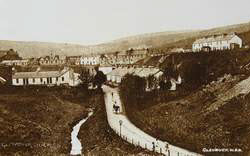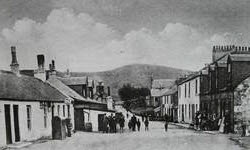Abandoned Communities ..... Ayrshire
The Central Ayrshire coalfield extends from just outside Ayr in the west to the border with Lanarkshire in the east. Coal mining developed rapidly during the nineteenth century, especially after the spread of the railway system.
A good summary of the history of coal mining in Ayrshire up to 1951 can be found in J Strawhorn & W Boyd, The Third Statistical Account of Scotland: Ayrshire, Oliver & Boyd, 1951, chapter 5.
Mining staff and their families lived in villages that lay close to the pits, and also in purpose built clusters of rows of small houses. This accommodation, generally cramped and lacking basic facilities, came under severe criticism before World War I, and over the subsequent decades action was gradually taken to provide more satisfactory housing.
In many places it was decided that it would not be economical to try to upgrade the existing housing. Instead remaining residents were offered transfers to housing developments elsewhere. Nearby villages and towns were enlarged to accommodate them, and after World War II the new town of Drongan was developed for the same purpose. This process led to the evacuation of several hamlets, and at the eastern end of the coalfield the village of Glenbuck was gradually abandoned.
We will begin with Glenbuck. It lay in the hills at the source of the River Ayr, about three miles east of Muirkirk. In his autobiography, to which we shall return later, Bill Shankly compared the location of Glenbuck to Outer Mongolia. The winters were cold and bitter, with four months of snow.
Bill Shankly, Shankly, Littlehampton Book Services, 1976.
The origins of the village at Glenbuck are not known, but by 1650 about 40 people were living there. The population increased to over 500 after 1760, when a weaving factory was opened. Then in 1786 major deposits of iron, coal, and limestone were discovered at Glenbuck, and within a few years an English company, the Glenbuck Iron Company headed by John Rumney, had obtained a lease to exploit them. Several mines, blast furnaces, forges, and a smithy were in operation by 1794. At the same time three short rows of houses were built south of the works, and another two rows to the west. Two houses were provided for mine officials, and some time later a general store was built.
The company had a 99 year lease, but after an initial period of successful operation financial difficulties started to emerge by 1799. After new funds were put into the company in 1805 production expanded again, and additional housing, in two storey blocks, was erected. Cast iron railway rails and water pipes were among the products of the works. Within a few years, however, the financial problems became intolerable, and production ceased in 1813.
More information about the Glenbuck Iron Company and its financial woes can be found in a paper entitled Glenbuck Ironworks 1790-1813, available at the library of the Baird Institute in Cumnock.
The section on Ayrshire of the second Statistical Account of Scotland, published in 1842, described Glenbuck as a village that had fallen into decay. But the huge coal reserves of the area were already well known, and after the development of steam locomotives and the railway system several pits were opened at Glenbuck. The village recovered, and by 1900 the population had risen to about 1750.
For the men of Glenbuck life was dominated by their work in the pits. Outside work, however, there was time to engage in a range of leisure activities, and in particular to take part in sport. An outstanding quoits player, Tom Bone, was born there in 1868. He gained the Scottish championship in 1889 after a narrow victory over Watters of Lochgelly, and then in 1908 he became champion of Great Britain after crushing James Hood of Liverpool by 61-27. He held the record for winning the Ballochmyle Silver Quoit, having won it no fewer than 14 times. Tom Bone did not marry, but lived in Glenbuck with his sister until his death in 1916.
For more on the quoits career of Tom Bone, and much more information about life at Glenbuck go to the Ayrshire History website at this address.
A good summary of the history of coal mining in Ayrshire up to 1951 can be found in J Strawhorn & W Boyd, The Third Statistical Account of Scotland: Ayrshire, Oliver & Boyd, 1951, chapter 5.
Mining staff and their families lived in villages that lay close to the pits, and also in purpose built clusters of rows of small houses. This accommodation, generally cramped and lacking basic facilities, came under severe criticism before World War I, and over the subsequent decades action was gradually taken to provide more satisfactory housing.
In many places it was decided that it would not be economical to try to upgrade the existing housing. Instead remaining residents were offered transfers to housing developments elsewhere. Nearby villages and towns were enlarged to accommodate them, and after World War II the new town of Drongan was developed for the same purpose. This process led to the evacuation of several hamlets, and at the eastern end of the coalfield the village of Glenbuck was gradually abandoned.
We will begin with Glenbuck. It lay in the hills at the source of the River Ayr, about three miles east of Muirkirk. In his autobiography, to which we shall return later, Bill Shankly compared the location of Glenbuck to Outer Mongolia. The winters were cold and bitter, with four months of snow.
Bill Shankly, Shankly, Littlehampton Book Services, 1976.
The origins of the village at Glenbuck are not known, but by 1650 about 40 people were living there. The population increased to over 500 after 1760, when a weaving factory was opened. Then in 1786 major deposits of iron, coal, and limestone were discovered at Glenbuck, and within a few years an English company, the Glenbuck Iron Company headed by John Rumney, had obtained a lease to exploit them. Several mines, blast furnaces, forges, and a smithy were in operation by 1794. At the same time three short rows of houses were built south of the works, and another two rows to the west. Two houses were provided for mine officials, and some time later a general store was built.
The company had a 99 year lease, but after an initial period of successful operation financial difficulties started to emerge by 1799. After new funds were put into the company in 1805 production expanded again, and additional housing, in two storey blocks, was erected. Cast iron railway rails and water pipes were among the products of the works. Within a few years, however, the financial problems became intolerable, and production ceased in 1813.
More information about the Glenbuck Iron Company and its financial woes can be found in a paper entitled Glenbuck Ironworks 1790-
The section on Ayrshire of the second Statistical Account of Scotland, published in 1842, described Glenbuck as a village that had fallen into decay. But the huge coal reserves of the area were already well known, and after the development of steam locomotives and the railway system several pits were opened at Glenbuck. The village recovered, and by 1900 the population had risen to about 1750.
For the men of Glenbuck life was dominated by their work in the pits. Outside work, however, there was time to engage in a range of leisure activities, and in particular to take part in sport. An outstanding quoits player, Tom Bone, was born there in 1868. He gained the Scottish championship in 1889 after a narrow victory over Watters of Lochgelly, and then in 1908 he became champion of Great Britain after crushing James Hood of Liverpool by 61-
For more on the quoits career of Tom Bone, and much more information about life at Glenbuck go to the Ayrshire History website at this address.
One
The road leading into Glenbuck
Glenbuck’s main street
These two pictures come from the collection of photographs at the Baird Institute in Cumnock, and are used by courtesy of East Ayrshire Council.
The same pictures, and other photographs of Glenbuck, can be seen in David Pettigrew, Old Muirkirk and Glenbuck, Stenlake Publishing, 1996.

